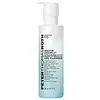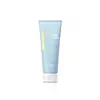What's inside
What's inside
 Key Ingredients
Key Ingredients

 Benefits
Benefits

 Concerns
Concerns

 Ingredients Side-by-side
Ingredients Side-by-side

Water
Skin ConditioningGlycerin
HumectantAcrylates Copolymer
Butylene Glycol
HumectantPolysorbate 20
EmulsifyingPotassium Cocoyl Glycinate
Cocamidopropyl Betaine
CleansingSodium Chloride
MaskingPotassium Cocoate
EmulsifyingSodium PCA
HumectantSqualane
EmollientCoco-Glucoside
CleansingGlyceryl Oleate
EmollientSodium Hydroxide
BufferingAlthaea Officinalis Root Extract
Skin ConditioningCitric Acid
BufferingSodium Phytate
Sodium Glycolate
BufferingCocamidopropyl Dimethylamine
EmulsifyingSodium Hyaluronate
HumectantSodium Benzoate
MaskingPotassium Sorbate
PreservativePropylene Glycol
HumectantHydrolyzed Silk
HumectantEthylhexylglycerin
Skin ConditioningTocopherol
AntioxidantHydrogenated Palm Glycerides Citrate
EmollientLecithin
EmollientAscorbyl Palmitate
AntioxidantPhenoxyethanol
PreservativeParfum
MaskingWater, Glycerin, Acrylates Copolymer, Butylene Glycol, Polysorbate 20, Potassium Cocoyl Glycinate, Cocamidopropyl Betaine, Sodium Chloride, Potassium Cocoate, Sodium PCA, Squalane, Coco-Glucoside, Glyceryl Oleate, Sodium Hydroxide, Althaea Officinalis Root Extract, Citric Acid, Sodium Phytate, Sodium Glycolate, Cocamidopropyl Dimethylamine, Sodium Hyaluronate, Sodium Benzoate, Potassium Sorbate, Propylene Glycol, Hydrolyzed Silk, Ethylhexylglycerin, Tocopherol, Hydrogenated Palm Glycerides Citrate, Lecithin, Ascorbyl Palmitate, Phenoxyethanol, Parfum
Water
Skin ConditioningGlycerin
HumectantCocamidopropyl Betaine
CleansingPropanediol
SolventPotassium Cocoyl Glycinate
Acrylates Copolymer
Polyglyceryl-4 Caprate
EmulsifyingHydroxypropyl Starch Phosphate
Sodium Chloride
Masking1,2-Hexanediol
Skin ConditioningLactic Acid
BufferingPotassium Cocoate
EmulsifyingEthylhexylglycerin
Skin ConditioningCitrus Aurantium Bergamia Fruit Oil
MaskingLavandula Angustifolia Oil
MaskingButylene Glycol
HumectantRosmarinus Officinalis Leaf Oil
MaskingCentella Asiatica Extract
CleansingPelargonium Graveolens Flower Oil
MaskingGardenia Florida Fruit Extract
Skin ConditioningCitrus Nobilis Peel Oil
MaskingMaltodextrin
AbsorbentBifida Ferment Lysate
Skin ConditioningHyaluronic Acid
HumectantGuaiazulene
AntimicrobialSqualane
EmollientCitric Acid
BufferingAllantoin
Skin ConditioningTocopherol
AntioxidantPanthenol
Skin ConditioningHydrolyzed Collagen
EmollientHamamelis Virginiana Leaf Water
AstringentHydrolyzed Hyaluronic Acid
HumectantCamellia Sinensis Leaf Extract
AntimicrobialJuniperus Communis Fruit Extract
PerfumingMelissa Officinalis Leaf Extract
Skin ConditioningSaponaria Officinalis Root Extract
Skin ConditioningSalvia Officinalis Leaf Extract
CleansingHouttuynia Cordata Extract
Skin ConditioningMentha Piperita Leaf Extract
Skin ConditioningViscum Album Leaf Extract
SoothingSodium Hyaluronate
HumectantCaprylic/Capric Triglyceride
MaskingAdansonia Digitata Seed Oil
EmollientHydrogenated Lecithin
EmulsifyingCeramide NP
Skin ConditioningCalendula Officinalis Extract
Skin ConditioningPropolis Extract
Skin ConditioningPalmitoyl Tripeptide-5
Skin ConditioningTocopheryl Acetate
AntioxidantRutin
AntioxidantHydroxycinnamic Acid
Skin ConditioningArtemisia Vulgaris Extract
Skin ConditioningMentha Rotundifolia Leaf Extract
TonicCeramide Ns
Skin ConditioningCeramide As
Skin ConditioningCeramide EOP
Skin ConditioningCeramide AP
Skin ConditioningMelaleuca Alternifolia Leaf Extract
PerfumingOligopeptide-1
Skin ConditioningDisodium EDTA
Limonene
PerfumingLinalool
PerfumingWater, Glycerin, Cocamidopropyl Betaine, Propanediol, Potassium Cocoyl Glycinate, Acrylates Copolymer, Polyglyceryl-4 Caprate, Hydroxypropyl Starch Phosphate, Sodium Chloride, 1,2-Hexanediol, Lactic Acid, Potassium Cocoate, Ethylhexylglycerin, Citrus Aurantium Bergamia Fruit Oil, Lavandula Angustifolia Oil, Butylene Glycol, Rosmarinus Officinalis Leaf Oil, Centella Asiatica Extract, Pelargonium Graveolens Flower Oil, Gardenia Florida Fruit Extract, Citrus Nobilis Peel Oil, Maltodextrin, Bifida Ferment Lysate, Hyaluronic Acid, Guaiazulene, Squalane, Citric Acid, Allantoin, Tocopherol, Panthenol, Hydrolyzed Collagen, Hamamelis Virginiana Leaf Water, Hydrolyzed Hyaluronic Acid, Camellia Sinensis Leaf Extract, Juniperus Communis Fruit Extract, Melissa Officinalis Leaf Extract, Saponaria Officinalis Root Extract, Salvia Officinalis Leaf Extract, Houttuynia Cordata Extract, Mentha Piperita Leaf Extract, Viscum Album Leaf Extract, Sodium Hyaluronate, Caprylic/Capric Triglyceride, Adansonia Digitata Seed Oil, Hydrogenated Lecithin, Ceramide NP, Calendula Officinalis Extract, Propolis Extract, Palmitoyl Tripeptide-5, Tocopheryl Acetate, Rutin, Hydroxycinnamic Acid, Artemisia Vulgaris Extract, Mentha Rotundifolia Leaf Extract, Ceramide Ns, Ceramide As, Ceramide EOP, Ceramide AP, Melaleuca Alternifolia Leaf Extract, Oligopeptide-1, Disodium EDTA, Limonene, Linalool
 Reviews
Reviews

Ingredients Explained
These ingredients are found in both products.
Ingredients higher up in an ingredient list are typically present in a larger amount.
Acrylates Copolymer is used as a film-forming agent and texture enhancer.
After applied, Acrylates Copolymer forms a thin film cover that helps skin feel more soft. It can help sunscreens become more water-resistant.
It is also used to make a product more thick.
Learn more about Acrylates CopolymerButylene Glycol (or BG) is used within cosmetic products for a few different reasons:
Overall, Butylene Glycol is a safe and well-rounded ingredient that works well with other ingredients.
Though this ingredient works well with most skin types, some people with sensitive skin may experience a reaction such as allergic rashes, closed comedones, or itchiness.
Learn more about Butylene GlycolCitric Acid is an alpha hydroxy acid (AHA) naturally found in citrus fruits like oranges, lemons, and limes.
Like other AHAs, citric acid can exfoliate skin by breaking down the bonds that hold dead skin cells together. This helps reveal smoother and brighter skin underneath.
However, this exfoliating effect only happens at high concentrations (20%) which can be hard to find in cosmetic products.
Due to this, citric acid is usually included in small amounts as a pH adjuster. This helps keep products slightly more acidic and compatible with skin's natural pH.
In skincare formulas, citric acid can:
While it can provide some skin benefits, research shows lactic acid and glycolic acid are generally more effective and less irritating exfoliants.
Most citric acid used in skincare today is made by fermenting sugars (usually from molasses). This synthetic version is identical to the natural citrus form but easier to stabilize and use in formulations.
Read more about some other popular AHA's here:
Learn more about Citric AcidCocamidopropyl Betaine is a fatty acid created by mixing similar compounds in coconut oil and dimethylaminopropylamine, a compound with two amino groups.
This ingredient is a surfactant and cleanser. It helps gather the dirt, pollutants, and other impurities in your skin to be washed away. It also helps thicken a product and make the texture more creamy.
Being created from coconut oil means Cocamidopropyl Betaine is hydrating for the skin.
While Cocamidopropyl Betaine was believed to be an allergen, a study from 2012 disproved this. It found two compounds in unpure Cocamidopropyl Betaine to be the irritants: aminoamide and 3-dimethylaminopropylamine. High-grade and pure Cocamidopropyl Betaine did not induce allergic reactions during this study.
Learn more about Cocamidopropyl BetaineEthylhexylglycerin (we can't pronounce this either) is commonly used as a preservative and skin softener. It is derived from glyceryl.
You might see Ethylhexylglycerin often paired with other preservatives such as phenoxyethanol. Ethylhexylglycerin has been found to increase the effectiveness of these other preservatives.
Glycerin is already naturally found in your skin. It helps moisturize and protect your skin.
A study from 2016 found glycerin to be more effective as a humectant than AHAs and hyaluronic acid.
As a humectant, it helps the skin stay hydrated by pulling moisture to your skin. The low molecular weight of glycerin allows it to pull moisture into the deeper layers of your skin.
Hydrated skin improves your skin barrier; Your skin barrier helps protect against irritants and bacteria.
Glycerin has also been found to have antimicrobial and antiviral properties. Due to these properties, glycerin is often used in wound and burn treatments.
In cosmetics, glycerin is usually derived from plants such as soybean or palm. However, it can also be sourced from animals, such as tallow or animal fat.
This ingredient is organic, colorless, odorless, and non-toxic.
Glycerin is the name for this ingredient in American English. British English uses Glycerol/Glycerine.
Learn more about GlycerinThis ingredient is the potassium salt of coconut acid. Coconut acid is created by mixing fatty acids from coconut oil.
It is an emulsifier, surfactant, and cleanser. According to a manufacturer, it contains glycerin.
Potassium Cocoyl Glycinate is an amino acid-based surfactant and cleaning agent. This ingredient can be derived from animals or plants. It may also be synthetically created from fatty acids of the coconut and glycine.
Potassium Cocoyl Glycinate is a gentle surfactant. Surfactants help gather the dirt, oil, and other pollutants from your skin to be rinsed away. It is a mild cleanser and naturally produces foam.
Chances are, you eat sodium chloride every day. Sodium Chloride is also known as table salt.
This ingredient has many purposes in skincare: thickener, emulsifier, and exfoliator.
You'll most likely find this ingredient in cleansers where it is used to create a gel-like texture. As an emulsifier, it also prevents ingredients from separating.
There is much debate on whether this ingredient is comedogenic. The short answer - comedogenic ratings don't tell the whole story. Learn more about comegodenic ratings here.
The concensus about this ingredient causing acne seems to be divided. Research is needed to understand if this ingredient does cause acne.
Scrubs may use salt as the primary exfoliating ingredient.
Learn more about Sodium ChlorideSodium Hyaluronate is hyaluronic acid's salt form. It is commonly derived from the sodium salt of hyaluronic acid.
Like hyaluronic acid, it is great at holding water and acts as a humectant. This makes it a great skin hydrating ingredient.
Sodium Hyaluronate is naturally occurring in our bodies and is mostly found in eye fluid and joints.
These are some other common types of Hyaluronic Acid:
Learn more about Sodium HyaluronateSqualane is an emollient that helps the skin hold onto moisture. It's an oily liquid that occurs naturally in certain types of fish and plant oils.
Because squalane boosts hydration in the skin, it also comes with plenty of benefits: it is an antioxidant and can help fight free radicals and skin damage. Squalane is also found to have a detoxifying effect when applied.
Squalane comes from squalene, which occurs naturally within the sebum of our skin. It is one of the oils our skin produces to keep itself hydrated. Squalane is the hydrogenated version of squalene and has a longer shelf life.
Research shows that squalane is non-irritating (even at 100% concentration).
In general, it's a fantastic ingredient. It does a great job at hydrating the skin, and it's suitable for those with sensitive skin.
The source of squalane may impact malassezia / fungal acne. This is because olive oil derived squalane can contain impurities such as fatty acids and plant waxes. Sugarcane derived squalane is recommended for anyone with malassezia concerns.
Is squalane vegan?
This depends on the source. Squalane can be derived from both plants and animals. Most squalane used in skincare comes from plants.
Please note: the source of squalane is only known if disclosed by the brand. We recommend reaching out to the brand if you have any questions about their squalane.
Read more about squalene with an "e".
Is squalane an oil?
Squalane is often called an oil, but it’s technically not; it’s a hydrocarbon, meaning it’s only made of carbon and hydrogen, unlike true oils which are triglycerides made of fatty acids and glycerol.
The term “oil-free” isn’t regulated, so companies can define it however they want. Some exclude all oils, while others just avoid mineral oil or comedogenic oils.
While some people avoid oils thinking they cause breakouts, the right kind of oil (or oil-like ingredient like squalane) can actually help balance and hydrate your skin. It’s worth testing out simple oils or squalane to see what works best for your skin.
Learn more about SqualaneTocopherol (also known as Vitamin E) is a common antioxidant used to help protect the skin from free-radicals and strengthen the skin barrier. It's also fat soluble - this means our skin is great at absorbing it.
Vitamin E also helps keep your natural skin lipids healthy. Your lipid skin barrier naturally consists of lipids, ceramides, and fatty acids. Vitamin E offers extra protection for your skin’s lipid barrier, keeping your skin healthy and nourished.
Another benefit is a bit of UV protection. Vitamin E helps reduce the damage caused by UVB rays. (It should not replace your sunscreen). Combining it with Vitamin C can decrease sunburned cells and hyperpigmentation after UV exposure.
You might have noticed Vitamin E + C often paired together. This is because it is great at stabilizing Vitamin C. Using the two together helps increase the effectiveness of both ingredients.
There are often claims that Vitamin E can reduce/prevent scarring, but these claims haven't been confirmed by scientific research.
Learn more about TocopherolWater. It's the most common cosmetic ingredient of all. You'll usually see it at the top of ingredient lists, meaning that it makes up the largest part of the product.
So why is it so popular? Water most often acts as a solvent - this means that it helps dissolve other ingredients into the formulation.
You'll also recognize water as that liquid we all need to stay alive. If you see this, drink a glass of water. Stay hydrated!
Learn more about Water